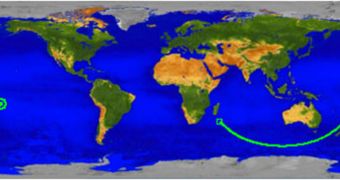Last Saturday, at 12:01 am EDT (0401 GMT), the NASA Upper Atmospheric Research Satellite (UARS) reentered the Earth's atmosphere while out of control, and crashed on the surface of the planet at an unknown location. A team featuring NASA and military personnel has just found the crash site.
The 6.5-ton satellite has been inactive for years, and it was scheduled to be deorbited this month. However, a series of issues eventually prevented mission controllers from managing the vehicle properly, and UARS spun out of control.
NASA and several other space agencies tried their best to monitor the situation, and predict where the satellite will hit the surface, but their efforts have largely failed due to improper tracking technologies.
The best these organizations could do was to establish the date when the vehicle reenters the atmosphere, as well as its approximate path. But experts still did not know where the UARS had landed even 24 hours after the incident, Space reports.
At one point, NASA had established a 1-in-3,200 chance that the UARS would hit somebody if it struck in the Unites States. Subsequent refinements in trajectory projections showed that the spacecraft was to fall around New Guinea but those estimates too proved to be false.
NASA and the Joint Space Operations Center at Vandenberg Air Force Base (VAFB), in California, determined that the satellite crashed at 14.1 degrees south latitude and 189.8 degrees east longitude (170.2 west longitude), in the Pacific Ocean.
The announcement was made yesterday, September 27. “Six years after the end of its productive scientific life, UARS broke into pieces during re-entry, and most of it up burned in the atmosphere,” a status update from the space agency explained.
“Twenty-six satellite components, weighing a total of about 1,200 pounds, could have survived the fiery re-entry and reach the surface of Earth. [The crash site is a] broad, remote ocean area in the Southern Hemisphere, far from any major land mass,” the statement adds.
“We extend our appreciation to the Joint Space Operations Center for monitoring UARS not only this past week but also throughout its entire 20 years on orbit,” add the chief scientist for orbital debris at NASA, Nick Johnson.
“This was not an easy re-entry to predict because of the natural forces acting on the satellite as its orbit decayed. Space-faring nations around the world also were monitoring the satellite’s descent in the last two hours and all the predictions were well within the range estimated by JspOC,” he adds.
Johnson is based at the NASA Johnson Space Center (JSC), in Houston, Texas.

 14 DAY TRIAL //
14 DAY TRIAL //